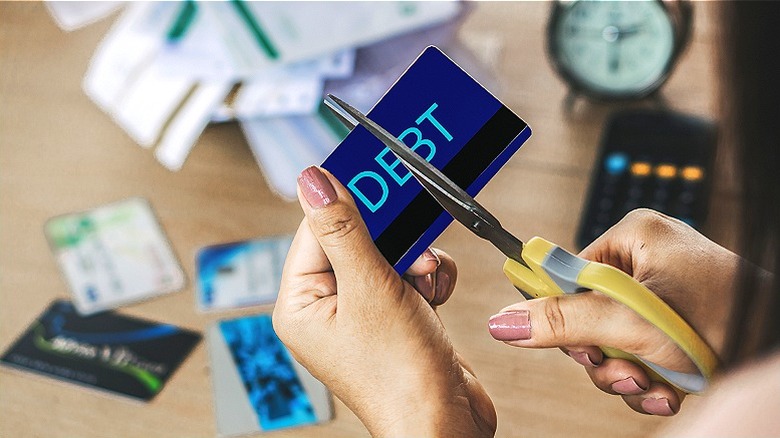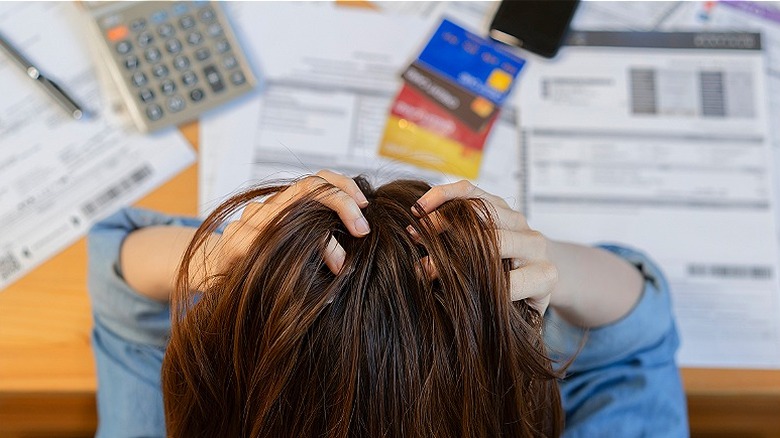What To Know About Credit Card Debt Forgiveness
Americans are increasingly dealing with the effects of credit card debt in their everyday finances. Budgeting with ballooning minimum payments is a tricky challenge that only gets harder the longer you put off a serious effort at tackling the debt issue looming in the background. U.S. household debt is truly gigantic in the modern financial landscape, with total credit card balances sitting at $1.13 trillion as of 2023's fourth quarter, per the Federal Reserve Bank of New York.
For those struggling with particularly high credit card bills and balances, debt forgiveness options might sound like the only way out of an ever-constricting cycle. But there are some things borrowers and credit card users should understand about debt forgiveness, credit card debt settlement, and any similar avenue. While this option may be right for some credit card users, it won't act as the silver bullet you might expect it to be for managing your debt. By keeping these points in mind, you'll be better able to make an informed decision about your credit usage and financial future.
Straight-up debt forgiveness is highly rare
The first thing anyone seeking a renegotiation of their current debt must understand is that true debt forgiveness is extremely rare. Essentially, if you pursue this avenue, you'll be asking your credit card issuer to allow you to keep the things you've purchased and discharge your debt. Asking already is a tall order, but this is just the beginning of your voyage into the world of credit card negotiating. Yet, it's perhaps even worth starting with this big ask upfront in order to negotiate a better deal at some point down the line.
If you've experienced an intense financial setback, like the death of a spouse or a long-term loss of work as a result of an injury, you might have some success in asking for debt forgiveness. A seismic change in financial circumstance paired with a responsible credit usage history could set the stage for success. This said, most people looking to alter their repayment structure will need to chase down a debt settlement option instead.
Payment plans can be arranged with your lender
Approaching your card issuer is the first step to renegotiating a repayment obligation — be that a debt forgiveness offer or something else. For many borrowers, a repayment plan alternative is likely the next point of negotiation. Your credit card company will want to get paid and will want to make it possible for you to achieve that end. As a result, many card companies will be willing to negotiate a new approach to paying off existing balances and will discuss repayment plan options that suit your budget, as well as offer flexibility surrounding some sort of temporary or long-term hardship.
The most important thing, though, when seeking to change the balance of your credit card payments is communication. If you don't reach out to your credit card company, it won't ever know you're in need of additional help to keep up with payments. These arrangements may include lower monthly contributions or a change to your payment due date. Ultimately, this action can go a long way toward improving your credit by helping you remain current on your bills and working toward a payoff.
Consider debt settlement, but be careful
Debt settlement is another approach credit card users might consider when looking to have some of their balance forgiven. Debt settlement can be done on your own, but many who choose this route of debt repayment work with a credit counselor or a debt settlement company that'll negotiate on their behalf. This approach is much like debt forgiveness but requires card users to pay back at least some of the total bill before the remaining balance can be discharged. Debt settlement is a viable solution to credit card debt that you can't handle, but it comes with some major consequences. Therefore, no one should go into the process of debt settlement without understanding the entirety of the decision.
First and foremost, debt settlement involves withholding your monthly payments, potentially for years as you pay into a settlement account rather than make payments directly. This will eviscerate your credit score in both the short and medium term, making new lending products very difficult to secure. However, it's possible to pay half or even less of your total bill and come out the other end without any credit card debt. Any accounts you work to settle will be closed at the conclusion of this process, leading to a long-term effect on your credit history, too. Lastly, it's important to remember that no settlement strategy is guaranteed so a company that promises results is perhaps one to shy away from when considering this approach.
Debt consolidation could be the better solution
Instead of tanking your credit score in order to clear your debts, a debt consolidation loan or a new credit card with specialized balance transfer offers might be the better solution. This approach won't see your credit card bills forgiven, but this kind of debt management option can act as a stronger path to both strong credit management and a preserved credit score that won't need to be rebuilt in the future.
Generally speaking, debt consolidation utilizes either a balance transfer or a loan in order to move multiple debts under the payment obligation of a single account. Oftentimes, borrowers will use a debt consolidation loan to reduce their monthly payment obligation as well. This offers the ability to create a little more leeway in the budget or to provide some wiggle room for overpayment.
Even though settlement is an acceptable way forward, especially for those drowning in credit card debt, some people would prefer to retain their accounts and pay off the debt, even if it means a larger overall bill that includes interest additions. A consolidation loan won't help you dramatically reduce your total repayment through the use of forgiveness or settlement, but it can help keep your financial bearings intact so you won't lose a step credit-wise after making dramatic strides forward in your repayment goals.
Bankruptcy may even be on the table
Perhaps the most dramatic approach to debt forgiveness is to go bankrupt. Filing for bankruptcy should be considered a measure of last resort, but it doesn't make it any less viable an option for debt forgiveness. There are two main types of bankruptcy that consumers can opt for and both come with a network of rules and requirements that will take some careful planning and consideration before, throughout, and after the process.
However, filing for bankruptcy can see much, if not all, of your credit card debt eliminated. While you may have to give back some of the things you purchased on any card covered by the bankruptcy, your ongoing debt situation can ultimately be put behind you with a bit of planning and the nerve to see this process of bankruptcy through.
Bankruptcy isn't something that should be taken lightly and this process will place a mark on your credit history that lasts for seven to 10 years. However, anyone who is exceedingly overwhelmed by debt with no clear way forward might consider the use of bankruptcy to have some or all of their credit card debt forgiven.





